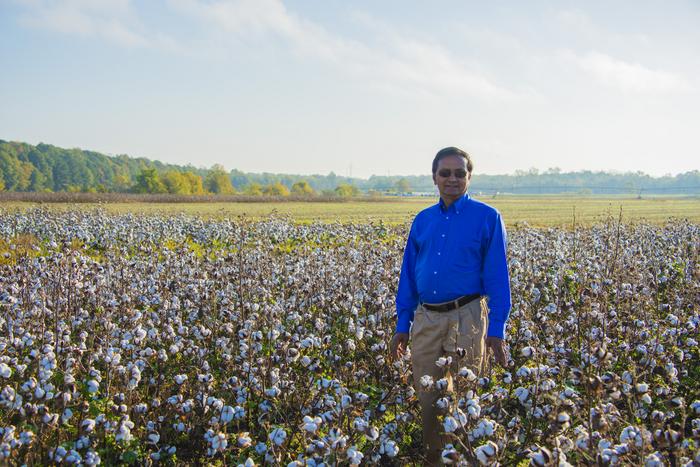STARKVILLE, Miss.—Does climate change have an impact on the quality of cotton? Mississippi State scientists hope to answer that question with a new way to monitor the environmental impacts on the cash crop throughout the growing season.

Credit: Photo by Dominique Belcher
STARKVILLE, Miss.—Does climate change have an impact on the quality of cotton? Mississippi State scientists hope to answer that question with a new way to monitor the environmental impacts on the cash crop throughout the growing season.
Researchers in the university’s Mississippi Agricultural and Forestry Experiment Station—in collaboration with the University of Nebraska-Lincoln’s Nebraska Water Center and the U.S. Department of Agriculture’s Agricultural Research Service—have produced the world’s first cotton quality module—a part of a larger forecasting tool—allowing cotton producers to better monitor crop quality under changing environmental conditions.
Details published earlier this month in Field Crops Research.
Cotton quality impacts how much—or little—money a farmer makes. Given its wide use in manufacturing, cotton is subjected to federal quality measurements. High-quality cotton fibers mean more income for the producer, while low-quality fibers could spell loss.
K. Raja Reddy, MSU Department of Plant and Soil Sciences research professor, working with Sahila Beegum, USDA Adaptive Cropping System Laboratory agricultural engineer in Beltsville, Maryland, developed a new cotton quality module that works with GOSSYM, a computer application that simulates the processes affecting cotton plant growth and yield. The acronym GOSSYM is derived from the scientific name of cotton, Gossypium. The application simulates cotton growth given selected weather, soil and management strategies. From there, it can predict crop growth, yield and now fiber quality.
GOSSYM was first developed in the 1980s. As new prediction modules are added, its accuracy and application for cotton producers and researchers is enhanced. The new cotton quality module, now a component of GOSSYM, is a result of pioneering MAFES research.
“While cotton is going through growth cycles, the cotton fiber quality will be affected by environmental conditions like temperature, rainfall and the nutrient quality of the soil and plant. All of these are included in the cotton quality module,” Reddy said.
The cotton quality module is the culmination of more than a decade of research between Reddy’s team and collaborators at the Nebraska Water Center. Controlled experiments within MAFES Soil Plant Atmospheric Research chambers studied how organs in the cotton plant responded to different environmental variables, with the end goal of predicting fiber quality.
The team has conducted experiments on 40 of the most frequently grown cotton plant varieties, making the quality module a robust tool for farmers. The module will be freely accessible for cotton producers and researchers to use across 74 million acres of cotton fields worldwide. It also has powerful implications in building resiliency to climate change. Researchers can now use the GOSSYM model to make future predictions on how climate shifts will alter cotton quality. Researchers can use this data to recommend changes in agricultural management or to propose new governmental policy.
“If we need irrigation to sustain the way we are growing cotton now, what changes do we need to make? Or, if we continue to use irrigation as we are now, will that be sustainable in the long term?” Reddy asked. “If you want to grow the same quality crop, what are the breeding strategies you might use to make the crops more heat or drought tolerant? These are the types of questions we can answer from the quality module.”
The team is currently working to produce an intuitive user interface that will allow individual farmers and researchers to easily use the quality module to monitor the future of a cotton crop’s quality.
The new module will provide MSU with innovative research opportunities as well. Reddy and Beegum are looking forward to a new project that will attempt to predict the best planting date to maximize cotton quality, year by year, across 17 Southern U.S. states.
The latest version of the GOSSYM source code, including the fiber quality module, is available on the USDA Adaptive Cropping Systems Laboratory GitHub page.
The Mississippi Agricultural and Forestry Experiment Station conducts plant production research to maximize yields while decreasing inputs and improving the environment. Find out more about MAFES at www.mafes.msstate.edu.
Mississippi State University is taking care of what matters. Learn more at www.msstate.edu.
Journal
Field Crops Research
Method of Research
Computational simulation/modeling
Subject of Research
Not applicable
Article Title
Planting for perfection: How to maximize cotton fiber quality with the right planting dates in the face of climate change
Article Publication Date
4-Jul-2024
COI Statement
The authors declare that they have no known competing financial interests or personal relationships that could have appeared to influence the work reported in this paper.



